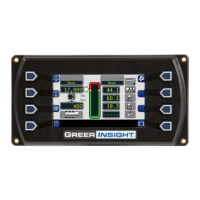9
W450311 Rev C 2/13
2.4 “No Fault Code” Problems
This section addresses problems not reported by the computer fault code system.
2.4.1 Anti-Two-Block Alarm (ATB)
This section gives aides diagnosing ATB alarm problems. For detailed information, schematic, and
voltages, refer to ANTI-TWO-BLOCK FUNCTION OVERVIEW.
PROBLEM:
• The Anti-Two-Block alarm is continuously ON. Operating the switch at the boom head does not
deactivate the alarm.
This problem suggests an open circuit between the computer ATB input and the ATB switch, or an
open circuit between the computer ATB feed and the ATB switch. Check the reeling drum cable for
damage. Ensure the two-block switches are correctly connected. Check the slip-ring and wiring inside
the extension reel. Check the reel-to-computer cable. Check the connectors.
PROBLEM:
• The Anti-Two-Block alarm is continuously OFF (safe). Opening the switch at the boom head, by
lifting the A2B weight does not activate the alarm.
This problem suggests a short circuit between the computer ATB input and the computer ATB feed
somewhere between the computer and the ATB switch. Check the reeling drum cable for damage.
Ensure the two-block switches are correctly connected. Check the slip-ring and wiring inside the
extension reel. Check the reel-to-computer cable. Check the connectors.
2.4.2 Displayed Load or Radius Errors
This section gives direction to fault diagnosis of load and radius errors. Load or radius errors can cause
early or late tripping of overload alarms. Accuracy of load is governed by the radius accuracy, and the
extension, angle, and pressure sensors. Accuracy of radius (unloaded) is governed by the extension
and angle sensors.
Ensure there are no system faults before continuing.
2.4.2.1 Check Boom Extension
1. Ensure the boom is fully retracted.
2. Ensure the reeling drum cable is correctly layered as a single layer across the extension reel
surface. Any stacking of the cable will cause extension errors. This will cause the System to
exceed the 0.5 ft tolerance allowed by the computer for boom mode selection. If the reeling
drum cable is stacking on the reel, refer to CHECKING THE REELING DRUM CABLE
LAYERING.

